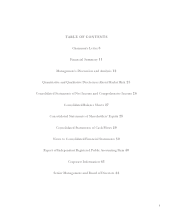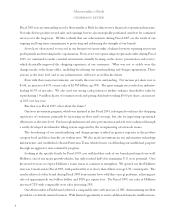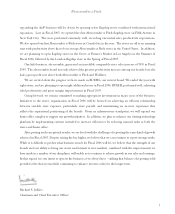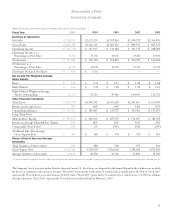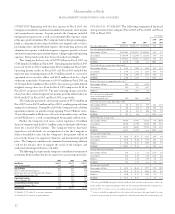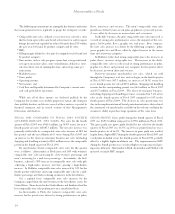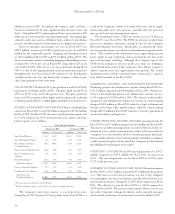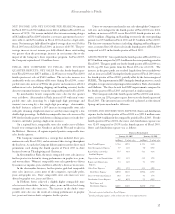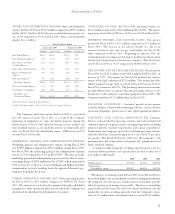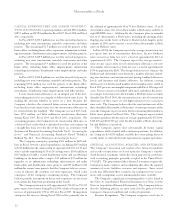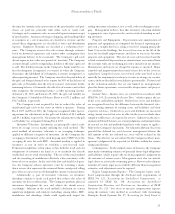Abercrombie & Fitch 2005 Annual Report Download - page 15
Download and view the complete annual report
Please find page 15 of the 2005 Abercrombie & Fitch annual report below. You can navigate through the pages in the report by either clicking on the pages listed below, or by using the keyword search tool below to find specific information within the annual report.
CURRENT TRENDS AND OUTLOOK During Fiscal 2005, the
Company made important expenditures in order to continue to devel-
op, enhance and protect the aspirational position of its brands.
Initially, the Company focused on its store base by completing the roll
out across all brands of the store investment program that started in
late Fiscal 2004. The Company added more sales floor coverage by
increasing the brand representative hours at the stores, which the
Company believes enhanced the customer’s in-store experience and
helped lower inventory shrink. Additionally, the Company imple-
mented a new store merchandise filling system and organized the
store stock rooms to improve merchandise replenishment efficiency.
Finally, the Company invested in its home office organization by
broadening the merchandising and design groups, providing the
Company with greater expertise at the product category level across all
brands, while creating leverage with its supplier base. Other home
office investments included the creation and launch of the Abercrombie
& Fitch Brand Protection Team, the Company’s new anti-counterfeiting
program, the development of its international support group, as well
as investments in its design and technical design groups.
During the fourth quarter of Fiscal 2005, the Company opened
the first Abercrombie & Fitch flagship store on 5th Avenue in New York
City. The store performed well throughout the fourth quarter of Fiscal
2005, exceeding management’s initial sales productivity expectations.
During January 2006, the Company also opened its first Abercrombie
& Fitch and Hollister stores in Canada. These stores are off to a strong
start with productivity above that of their respective average U.S. coun-
terparts. The Company plans to open additional flagship locations in
Los Angeles during Fiscal 2006 and London in early 2007.
The Company views the Hollister brand as a significant growth
vehicle for the Company in the future, with the brand having reached
only half of its maximum store potential; Abercrombie & Fitch is a matur-
ing brand with its opportunity for future growth and contribution
depending on securing prime locations for its stores and expanding the
brand and its presence outside of the United States; abercrombie is viewed
as having growth opportunities within the United States; management
continues to refine RUEHL’s merchandise mix, marketing strategy
and store presentation to position the brand for long-term profitability.
For Fiscal 2006, the Company will be faced with the challenge of
improving on Fiscal 2005’s successful business. The Company has
begun to annualize the strong comparable store sales growth, which
started in January 2005. While the Company believes it can sustain
positive comparable store sales increases in Fiscal 2006, the increases
are not expected to be at the level reported during Fiscal 2005.
Management will operate the business as it always has – it will protect
and enhance the brands and work to ensure their long-term success.
While the Company has been able to improve its Initial Markup
(“IMU”) in the past, management does not anticipate any IMU
improvements in its forecasts or projections. The Company ended the
fourth quarter of Fiscal 2005 with inventories, at cost, up 59% per gross
square foot versus the fourth quarter of Fiscal 2004 as a result of the
Company’s investment in the jeans business and other basic categories.
The Company will continue to invest in key inventory categories to
drive business while actively managing its markdown exposure. The
Company believes it will end the first quarter of Fiscal 2006 with a
slightly lower increase in inventory per gross square foot, at cost, when
compared to the fourth quarter of Fiscal 2005.
During Fiscal 2006, the Company will continue to focus on the
customer’s in-store experience. The Company expects that the on-going
management of the store investment program initiatives will be
evaluated primarily by store sales performance, with consideration for
customer service, shrink and other aspects of the customer’s in-store
experience. Additionally, the Company plans to continue to make
capital expenditures to invest strategically in the appearance of its
stores, primarily in Abercrombie & Fitch and Hollister stores. These
investments will allow the Company to update some of its older stores
without having to do full remodels.
The Company plans to make an investment during Fiscal 2006 in
home office organizations and information technology infrastructure
to enhance and increase efficiencies in its systems. The Company
expects its payroll expense, excluding the impact of stock option
expensing, to increase at a lower rate during Fiscal 2006 than it did
during Fiscal 2005. Additionally, the Company also expects depreciation
and amortization expense for the home office to increase during Fiscal
2006 as a result of the capital expenditures it incurred during Fiscal
2005, primarily due to the addition of a new office building.
Historically, the Company has reported stock-based compensation
through the disclosure-only requirements of Statement of Financial
Accounting Standards (“SFAS”) No. 123, “Accounting for Stock-Based
Compensation,” as amended by SFAS No. 148, “Accounting for Stock-
Based Compensation–Transition and Disclosure–an Amendment of FASB
Statement No. 123,” but elected to measure compensation expense
using the intrinsic value method in accordance with Accounting
Principles Board Opinion No. 25, “Accounting for Stock Issued to
Employees.” Accordingly, no compensation expense for options has
been recognized as all options have been granted at fair market value
at the grant date. In accordance with SFAS No. 123(Revised 2004),
“Share-Based Payment,” the Company will begin to recognize expense
for stock options granted to the Company’s associates and non-associ-
ate directors beginning with the first quarter of Fiscal 2006, which will
have an adverse impact on the Company’s reported net income. Based
on stock options previously issued, but not fully vested, and an estimate
of stock options to be granted during Fiscal 2006, the Company expects
that the implementation of SFAS No. 123(R) will result in a charge of
approximately $0.10 per fully-diluted share for Fiscal 2006.
Abercrombie &Fitch
13


